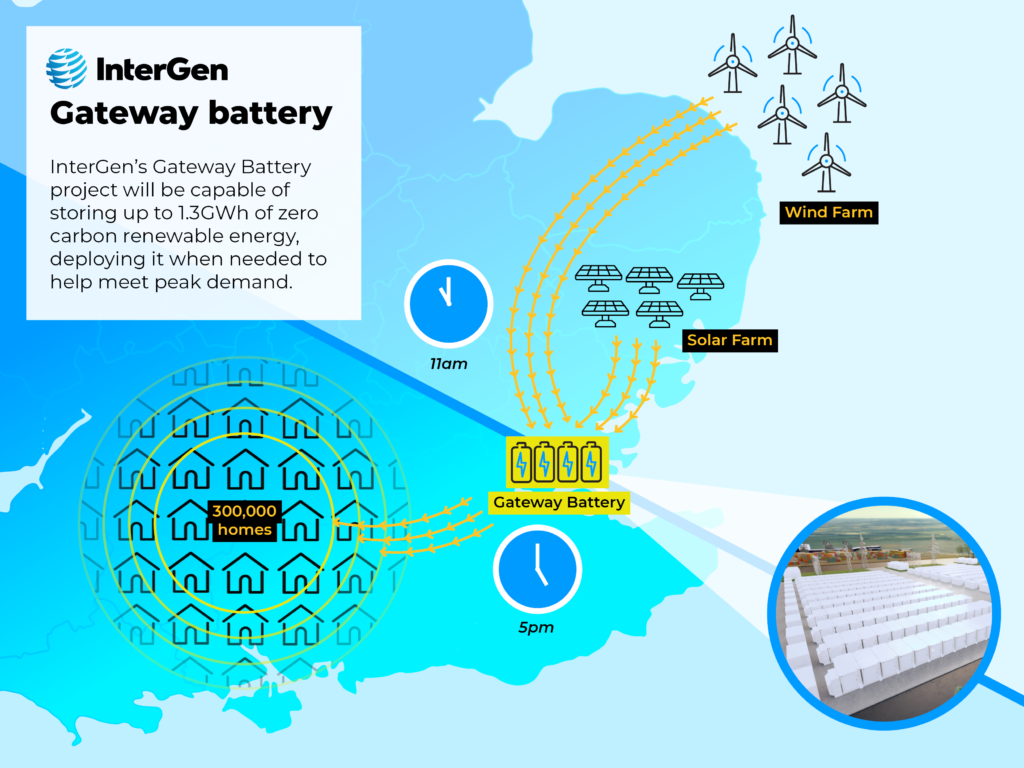 InterGen has been granted consent by BEIS to deliver one of the world’s largest battery storage project on the banks of the Thames in Essex. The project, which could ultimately deliver 1.3GWh of power, dwarfs any similar projects currently in operation in the UK, with the largest operational project presently 75MWh.
InterGen has been granted consent by BEIS to deliver one of the world’s largest battery storage project on the banks of the Thames in Essex. The project, which could ultimately deliver 1.3GWh of power, dwarfs any similar projects currently in operation in the UK, with the largest operational project presently 75MWh.
When fully charged, the battery could power up to 300,000 homes for two hours. However, it will mostly be used to support and stabilise existing electricity supplies.
The ongoing growth of renewable energy sources such as wind and solar is critical to the UK achieving its ambitions to reach net zero emissions by 2050. However, these sources only generate electricity when the wind blows or sun shines, and this may not be when power is most needed by the grid.
This situation has led to a significant growth in the use of batteries to support the electricity system, since these can store the renewable energy generated by wind and solar for deployment when it is most needed.
However, no project in the UK has the scale of the InterGen Gateway proposal. As such, it represents a major piece of the system architecture required to help support the transition to net zero.
Construction on the Gateway project would likely begin in 2022, becoming operational in 2024. InterGen is also exploring a further large battery project at its site in Spalding, Lincolnshire, which would be 175MW / 350MWh. The planning permissions are already in place for this.
InterGen CEO Jim Lightfoot said, “We are delighted to have been granted consent by BEIS for the Gateway project. Our mission is to deliver the flexible electricity solutions that everyone relies on in a low-carbon world, and this project is a major statement of intent. We are excited to be entering a new phase in our growth as an organisation, and will continue to explore opportunities to develop projects which can support the energy transition.”





Correction:
https://www.pv-magazine.com/2020/11/30/europes-largest-battery-project-gets-approval-in-the-uk/
(The largest project is in the USA)
Hi Juri,
That is the same project mentioned above We didn’t say it was the largest in the world just the UK, although it may well be the largest in Europe too.
Accepted Tim,
my excuses.
The reason the USA has the largest battery storages in planning is the direct energy transition leaving atom and FF behind and by the market forces not opting for gas. A different aproach from that in the UK where the A-bomb is subsidised via the lecky bill, where people are forced by the governments to subsidise atom power plants.
I gave the links towards the infos in my second pcomment here yesterday but they seem to be censored.
My link towards
It would be interesting to know what kind of battery technology will be used in this Intergen project; perhaps a combination of technologies?
Hi David,
Intergen uses lithium-ion batteries
Thanks Tim,
I would have expected them to have a mix of Lithium-ion and flow batteries, like the Oxford energy park.
Meanwhile have I just watched the FT webinar on Energy transition strategies summit, which was a useful insight into what is going on outside the UK.